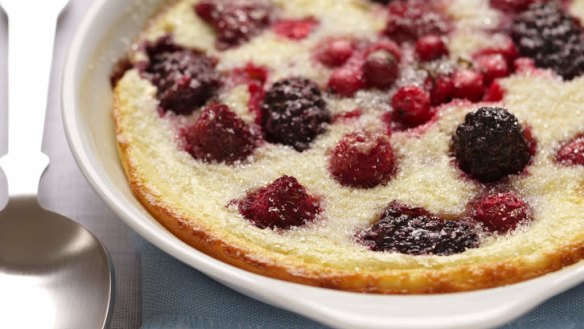Why does my clafoutis always turn out so rubbery?

Why does my clafoutis always turn out so rubbery? E. Charles
This classic French baked dessert of cherry, in a moist egg and flour batter, is the perfect last hurrah for what has been a rather excellent cherry season. This is a dish's whose texture is determined by eggs – the desired result is soft and slightly wobbly. The world of egg cookery is dominated by the rich flavour and texture delivered by the yolk, and the way heat transforms the loose strands of protein in the albumen into a tightknit network that can enmesh liquid in a custard, which can undulate with the slightest of touch, or result in a turgid mousse. Time, temperature and amount of egg used determine the final outcome. I draw upon two egg dishes – the Spanish revueltos, all soft, moist and creamy, and hotel buffet scrambled eggs, all tight, rubbery and oozing with liquid. They are basically the same dish except the cooking of the soft revueltos is halted as the eggs congeal, the latent heat finishing the dish to its silky conclusion. Scrambled eggs are the same but with the bejesus cooked out of them. With your clafoutis perhaps reduce the cooking time by five to 10 minutes or turn the oven down by 10 degrees. Make sure the eggs are the right size as too much egg white to flour will make a more rubbery texture. As my editors keep telling me: "You don't want to overegg the pudding".
If salami is a fermented food why doesn't it make me drunk? J. Stock
Now there's a marketing opportunity if ever I saw one – alcoholic smallgoods! My only concern would be how long it would take the beverage industry to mix sopressa with Coke to make it Ready to Drink. There are lots of different types of fermentation that take place in food production. Alcoholic fermentation is the obvious one when yeast turns sugars into alcohol and CO2. But what about acetic fermentation when acetobacter – known as vinegar bacteria – turn alcohol into acetic acid, which we generally call vinegar? Then there are bacteria thatwork at very high levels of salt concentration to help transform the flesh of fish during anchovy production. In traditional salami production, lactobacillus bacteria munch away at naturally occurring sugars in the meat and transform these into lactic acid. As the salami gets more acidic it makes the meat less hospitable to bad bacteria. The addition of salt also helps prevent bad bugs. After the initial fermentation period salamis are hung in a low-humidity, low-temperature environment where they dry to complete the curing process.
How can ricotta sold in baskets with a two to three week use-by date be a "fresh" cheese? C. French
The "fresh" in fresh cheeses refers to the fact that they are not further matured using moulds or ageing. Ricotta is traditionally made from wheythat is fermented which acidifies the liquid and helps the protein to coagulate. The acidified whey is then heated, or re-cooked (hence ricotta) which forces the protein to form lumps. The mixture is strained then vacuum-sealed, giving a shelf life of 28 days from manufacture. Most manufacturers recommend that once opened, ricotta must continue to be stored below 5C and used within three days, although the CSIRO allows 10 days. Tightly seal opened ricotta, as it rapidly takes on aromas of other fridge inhabitants such as rockmelon.
What's a "new potato"? N. Lee
We think of potatoes as winter vegetables as that's when we enjoy them the most, roasted with a juicy joint or mashed to serve under snorkers and onion gravy. But now is their harvest time. Potatoes are tubers that grow underground. When potatoes mature the plants above ground wither and the skin on the potatoes hardens, protecting the potato and enabling it to last for months. New potatoes are basically immature potatoes, harvested early, with a very fine skin and sweet flesh. They don't store well and are best steamed or boiled and served with butter and in a potato salad with sour cream with dill and mint.
Send your vexing culinary conundrums to brainfood@richardcornish.com.au or tweet to @Foodcornish
The best recipes from Australia's leading chefs straight to your inbox.
Sign up